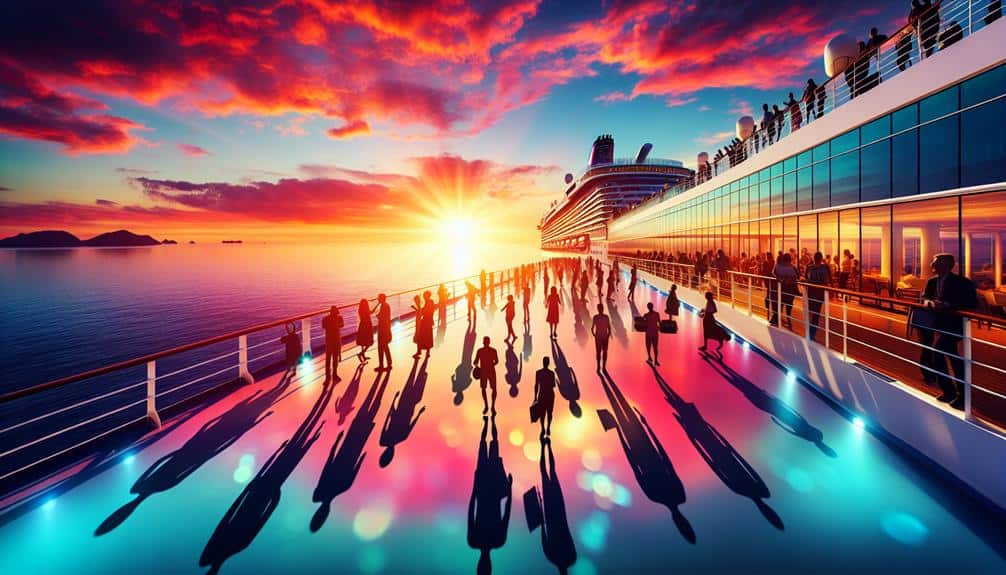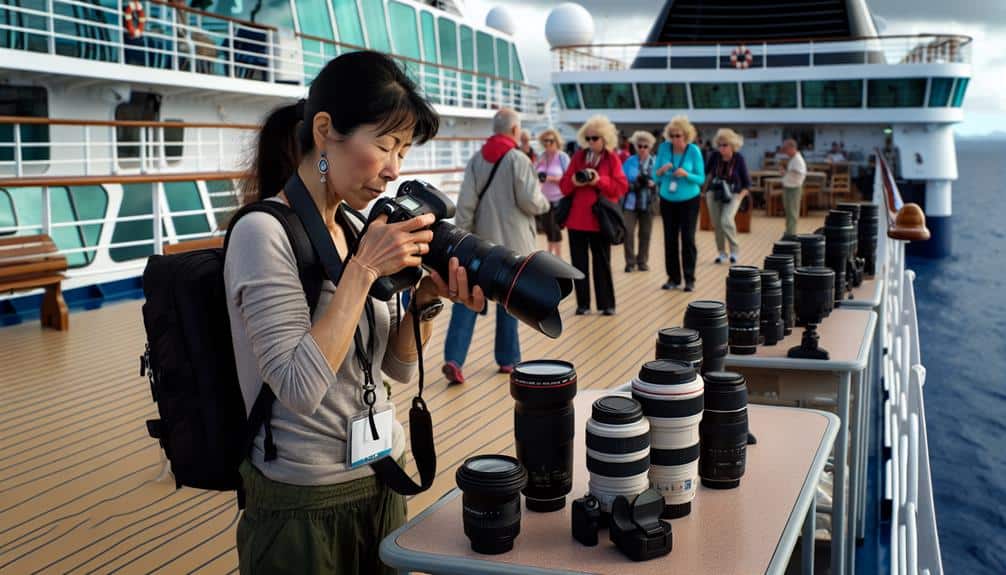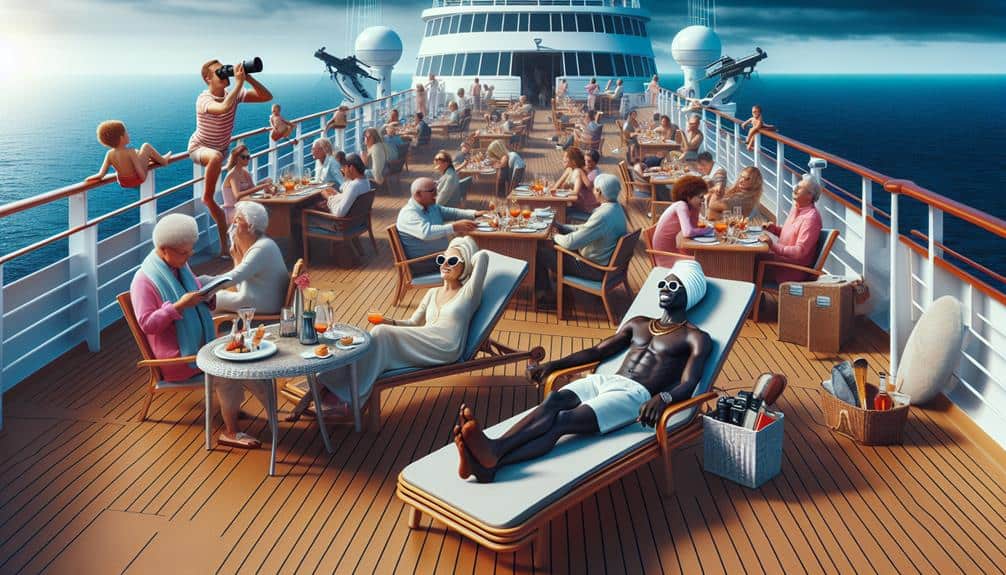To capture the sea's beauty onboard effectively, endeavor for balanced composition, adhere to the rule of thirds, and incorporate leading lines to create depth and movement. Experiment with lighting manipulation to enhance visual impact and utilize reflections to add dimension to nautical shots. Seek out marine wildlife encounters for unique photography opportunities and utilize advanced camera equipment for precise captures. Enhance sea imagery through color correction, tone adjustments, and texture enhancements to convey the essence of the marine world with finesse. Mastering these techniques will elevate your seascapes to new heights.
Key Points
- Utilize natural light for its clarity and depth.
- Capture reflections on the water's surface for added dimension.
- Position subjects strategically for visually appealing compositions.
- Experiment with angles and perspectives to create dynamic shots.
- Enhance colors and textures in post-processing for a captivating look.
Composition Tips for Stunning Seascapes
To capture stunning seascapes, prioritize balance in your composition, ensuring a harmonious arrangement of elements within the frame. Adhering to the rule of thirds can greatly enhance your marine photography. Consider dividing your frame into a 3×3 grid, both horizontally and vertically, resulting in nine equal parts. Position key elements, such as the horizon line or a focal point like a boat or rock formation, along these lines or at their intersections. This technique creates a sense of balance and visual interest that can draw the viewer's eye into the scene.
Furthermore, integrating leading lines into your composition can guide the viewer's gaze through the image, creating depth and a sense of movement. Use natural elements like waves, shorelines, or even man-made structures such as piers or ropes to lead the viewer towards the main subject. By skillfully incorporating leading lines and adhering to the rule of thirds, you can elevate your seascapes to a new level of artistry.
Lighting Techniques for Marine Photography
When capturing marine photography, skillful manipulation of lighting can greatly enhance the visual impact of your images. Lighting plays an important role in underwater exploration, as it can reveal the true colors and textures of the natural elements beneath the surface. Understanding how light behaves underwater is essential for capturing stunning marine photographs.
Natural light is one of the most significant factors to take into account when photographing marine environments. As you descend into the depths, the intensity and color of the light change, affecting how your subjects appear in the frame. Utilize natural light to your advantage by positioning yourself in relation to the sun and adjusting your camera settings accordingly.
In addition to natural light, artificial lighting sources such as strobes and underwater lights can be used to highlight specific areas or creatures in the frame. Experiment with different angles and intensity levels to create dramatic effects and draw attention to the details of your underwater subjects. Mastering lighting techniques is key to capturing the beauty of the sea in all its glory.
Utilizing Reflections for Nautical Shots
Reflections on the water's surface can add an enchanting dimension to nautical shots, enhancing the visual interest and depth of your marine photographs. When capturing nautical scenes, pay close attention to the water ripples. These mesmerizing movements create alluring reflections, adding a dynamic element to your photos. During sunset, the water's surface transforms into a mirror, perfectly mirroring the colors of the sky and surrounding elements. This phenomenon creates stunning sunset silhouettes, where the dark outlines of boats or coastal structures contrast beautifully against the vibrant hues reflected on the water.
To make the most of reflections in your nautical shots, position yourself strategically to capture both the subject and its reflection. Utilize the natural light during sunset to enhance the contrast between light and dark elements. Experiment with different angles and perspectives to find the most compelling composition that highlights the water ripples and sunset silhouettes. By mastering the art of utilizing reflections in your marine photography, you can elevate the beauty and allure of your nautical shots.
Capturing Wildlife in Oceanic Settings
In oceanic settings, observing and capturing wildlife in their natural habitats offers a unique opportunity to witness the intricate interactions of marine species.
- Underwater Expeditions: Venturing beneath the waves during underwater excursions allows for unparalleled wildlife encounters. The silent world below the surface reveals a bustling ecosystem where creatures move with grace and purpose.
- Seafaring Adventures: Setting sail on seafaring journeys provides a platform for observing marine life interactions. Dolphins playfully leap in the ship's wake, while schools of fish dart in synchronized patterns, creating a mesmerizing spectacle.
- Photographic Documentation: Utilizing advanced camera equipment enables the precise capture of wildlife behaviors. From the elegant dance of a sea turtle to the swift hunting techniques of a barracuda, each moment can be frozen in time.
- Conservation Awareness: Through capturing wildlife in oceanic settings, a deeper appreciation for the delicate balance of the marine world is fostered. These images serve not only as visual delights but also as reminders of the importance of protecting our oceans.
Editing Tools for Enhancing Sea Imagery
Enhance sea imagery with specialized editing tools designed to elevate the visual quality and impact of marine photographs. When it comes to editing sea imagery, color correction plays an essential role in ensuring that the hues of the ocean, sky, and marine life are accurately represented. Utilizing advanced color correction tools allows you to adjust the tones and saturations to achieve a harmonious and realistic look in your images.
In addition to color correction, texture enhancement is another key aspect of editing sea imagery. By fine-tuning the textures of the water, sand, or marine creatures, you can bring out intricate details and create a more tactile viewing experience. Tools that enable texture enhancement help you emphasize the intricate patterns and surfaces present in your sea photographs, adding depth and visual interest to your compositions.
Mastering these editing techniques won't only enhance the beauty of your sea imagery but also allow you to convey the mesmerizing essence of the marine world with precision and finesse.
Frequently Asked Questions
How Can I Protect My Camera Equipment From Saltwater Damage While Shooting at Sea?
To protect your camera equipment from saltwater damage while shooting at sea, invest in waterproof gear or a protective housing. After use, promptly clean gear with fresh water and dry thoroughly to prevent corrosion.
What Are Some Common Challenges Photographers Face When Shooting Seascapes, and How Can They Be Overcome?
When shooting seascapes, you face lighting challenges and composition decisions. Timing shots right is essential. Improve your editing skills for post-processing. Overcome challenges by mastering these elements. Enhance your ability to capture the sea's beauty.
Are There Any Specific Weather Conditions That Are Ideal for Capturing the Beauty of the Sea?
Ideal weather conditions for capturing the sea's beauty include the best lighting during sunrise or sunset. Perfect timing allows for dramatic colors and reflections. Embrace clear skies or scattered clouds for dynamic compositions, enhancing the sea's allure.
What Are Some Creative Ways to Incorporate Human Subjects Into Marine Photography?
Incorporating human subjects into marine photography involves capturing underwater portraits and interactions with ocean wildlife. Utilize creative angles and lighting to merge the beauty of marine landscapes with the human element, creating engaging compositions.
How Can Photographers Ensure That Their Sea Imagery Stands Out in a Saturated Market of Oceanic Photography?
To guarantee your sea imagery stands out, concentrate on mastering lighting techniques and composition tips. Utilize editing tricks for enhancing details. Employ strategic marketing strategies to reach a wider audience and showcase your unique oceanic perspective.



